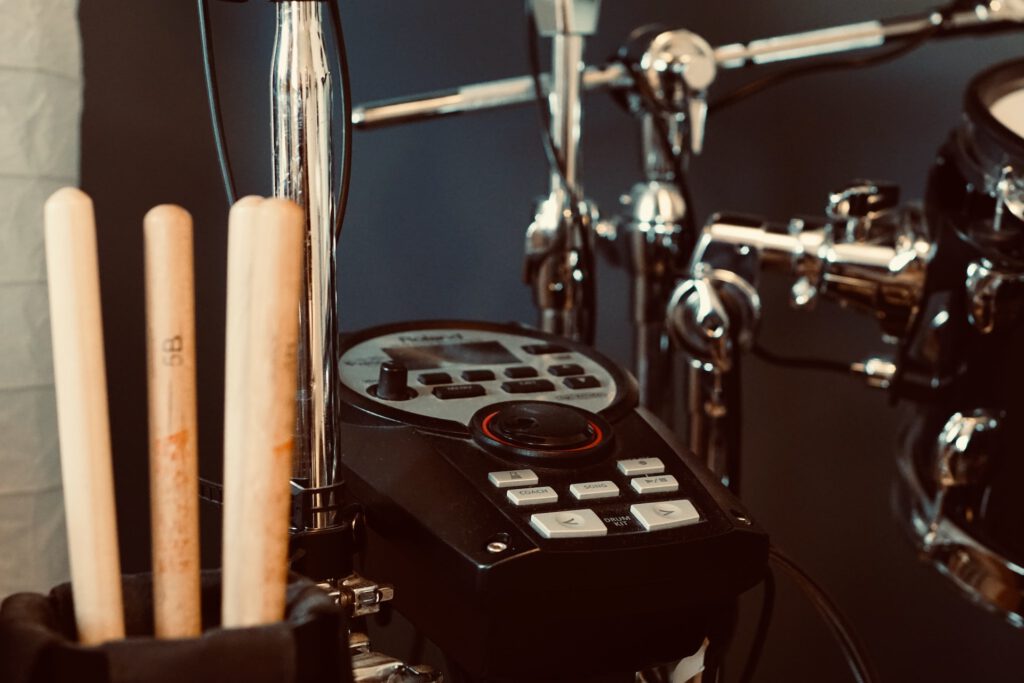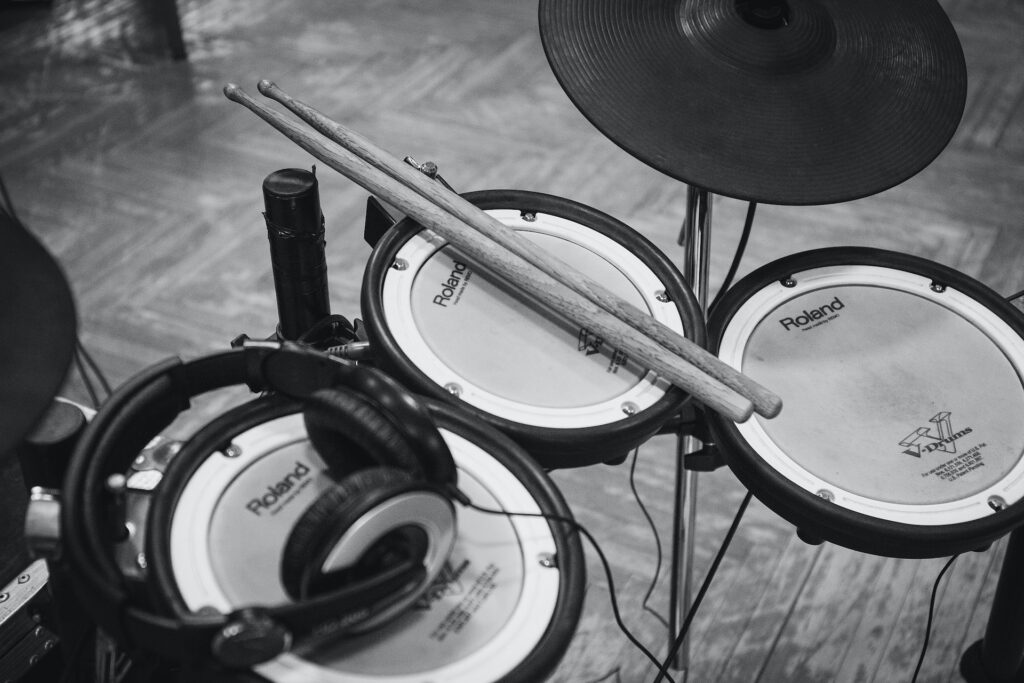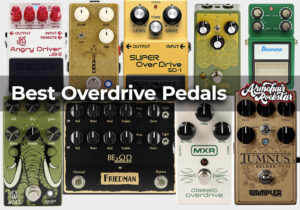If you’re considering buying a used electronic drum set, there are several factors you need to consider to ensure you get the best value for your money.
As a drummer, I’ve had my fair share of experiences with both acoustic and electronic drum sets. Over the years, I’ve come to appreciate the convenience and versatility of electronic drum sets. I’m still an acoustic guy at heart, but a few years of apartment life changes things. I’ve also bought a few lemons.
Here are some key points to keep you from doing the same thing:
- Set Your Budget
- Do Your Homework
- Think About the Future
- Starting Your Search
- Go Back in Time
- Explore Compatibility & Expandability
- Condition Assessment
- Spare Parts Availability
- Software Compatibility
- Research the Seller
In the market for a brand-new beginner electronic drum kit? Check out our full Beginner’s Electronic Drum Kit Buyer’s Guide.
Set Your Budget: The First Step in Buying a Used Electronic Drum Set
Why It’s Important: Knowing your budget not only prevents overspending but also helps in narrowing down choices. Every purchase, especially one as significant as an electronic drum set, requires financial planning. Setting a clear budget is paramount
Expert Tip: Always factor in potential additional costs such as replacement parts or upgrades. It’s also wise to have a small buffer in your budget for unforeseen expenses.
Before diving into the market, it’s essential to determine your spending limit. This not only helps in narrowing down options but also ensures you don’t end up with buyer’s remorse. While it might be tempting to opt for the cheapest set available, it’s crucial to remember that quality and durability often come at a price.
For instance, renowned brands like Roland, Yamaha, and Alesis are known for their quality and durability. While their products might be on the pricier side, they often offer better value in the long run. On platforms like eBay and Reverb, you can get an idea of the current market value of specific kits, helping you set a realistic budget.
Furthermore, an article from MusicRadar emphasizes the importance of setting a budget, especially when considering used equipment. The article suggests that while there are savings to be had when buying used, especially from big-name brands, it’s essential to be well-informed about what you’re purchasing to avoid potential pitfalls.
Setting a budget is not just about determining a number. It’s about understanding the market, anticipating future needs, and ensuring you get the best value for every dollar spent.
Do Your Homework: Dive Deeper into the World of Electronic Drum Sets
Why It’s Important: The realm of electronic drum sets is vast and ever-evolving. With a plethora of brands, models, and features available, it’s easy to feel overwhelmed. Doing thorough research ensures you make an informed decision tailored to your specific needs, rather than making an impulsive purchase you might regret later.
Expert Tip: Creating a list is a practical approach. Jot down the features you absolutely cannot compromise on, and then list those that would be nice to have but aren’t deal-breakers. This structured approach will streamline your search and help you quickly identify whether a particular kit aligns with your requirements.
Understand what features are essential for your needs. Are you a beginner looking for ease of use and a broad range of sounds? Or are you a semi-pro drummer looking for advanced triggering functions and expandable inputs? Research the current market to get an idea of what features are available on new kits. This will give you a benchmark for comparing used kits.
Creating a list is a practical approach. Jot down the features you absolutely cannot compromise on, and then list those that would be nice to have but aren’t deal-breakers. This structured approach will streamline your search and help you quickly identify whether a particular kit aligns with your requirements.
Think About the Future: Investing in a Drum Set That Grows with You
Why It’s Important: The journey of a drummer is one of constant evolution. As you hone your skills, explore different genres, and perhaps even venture into recording or live performances, your requirements from your drum kit will change. Investing in a kit that can adapt to these evolving needs ensures you’re not left wanting more just a few years down the line.
Expert Tip: While it’s tempting to focus solely on your current needs, it’s wise to think long-term. Kits that offer expandability and are compatible with emerging technologies will serve you well in the long run. Even if certain features seem superfluous now, they might become indispensable as you progress.
Technology, especially in the electronic drum world, evolves rapidly. While you might not need certain features now, think about where you want to be with your drumming in a few years. Features like Bluetooth capabilities, USB connectivity, or the ability to add extra pads might become essential down the line.
Thinking ahead can save you from future expenses and the hassle of upgrading too soon. Investing in a versatile, expandable, and technologically compatible drum set ensures you have a companion that grows with you on your drumming journey.
Starting Your Search: Navigating the Electronic Drum Set Market
Why It’s Important: The electronic drum set market is vast, with a plethora of options ranging from entry-level kits to professional-grade setups. Initiating your search with a broad perspective allows you to gauge the market landscape, understand the going rates for various kits, and identify the features that are standard across different price points.
Expert Tip: Online marketplaces are treasure troves of information. Utilize the filter options to narrow down listings based on your specifications, such as brand, price range, and features. This will help you quickly identify kits that align with your needs and budget.
Starting your search with generic terms like ‘electronic drum set’ can provide a comprehensive overview of the available options. Websites like eBay are invaluable resources, offering insights into the current market value of specific kits, user reviews, and even seller ratings.
However, eBay isn’t the only platform to consider:
- Reverb: Reverb is a dedicated platform for musicians, offering both new and used musical instruments. Their listings often come with detailed descriptions, high-quality images, and user reviews, giving you a comprehensive understanding of the product.
- Drumming Review: This website offers detailed reviews and guides on various electronic drum sets. Their insights can help you understand the pros and cons of different kits, ensuring you make an informed decision.
- Drumeo: Drumeo provides a detailed guide covering electronic drum kits across different price ranges. Their hands-on experience with various products offers valuable insights, helping you identify the best kit for your needs.
- Facebook Marketplace: While the specific listings might vary based on your location, Facebook Marketplace can be a great platform to find local sellers. This not only allows you to potentially test the kit before purchasing but also saves on shipping costs.
While starting your search broadly can provide a general overview, diving deeper into specialized platforms and leveraging their filtering tools can help you pinpoint the perfect electronic drum set for your needs. Remember, it’s not just about finding a kit within your budget, but also about ensuring it aligns with your drumming aspirations and offers value for money.

Go Back in Time: The Value of Vintage Electronic Drum Sets
Why It’s Important: In the world of electronic drumming, newer isn’t always better. Vintage or older models can offer a unique sound and feel that some drummers prefer. Moreover, they can provide excellent value for money, especially if you’re looking for specific features that have become rare in modern kits.
Expert Tip: Certain older drum kits have gained a cult-like following due to their unique sound or groundbreaking features. If you stumble upon such a gem, it might be a worthy investment, both in terms of musical value and potential resale value.
Some used kits might be out of production. Research older models to understand their functionality and configuration. Reviews, YouTube videos, and forums can provide insights into the pros and cons of specific models.
When considering older models, it’s essential to delve into the history and evolution of electronic drum sets. This will give you a clearer understanding of the features and sound quality you can expect.
- The Roots of Electronic Drumming: The journey of electronic drums began in the 1960s with pioneers like Felix Visser experimenting with the Ace Tone electronic rhythm box. Interestingly, Ace Tone eventually evolved into Roland, one of today’s leading electronic drum manufacturers. Source
- The Rise of the Electronic Drum Kit: The late 1970s and early 1980s saw the emergence of commercial electronic drums. Brands like Simmons introduced kits like the SDS-5, which became iconic in the 1980s music scene. These kits offered unique sounds that became synonymous with the electronic music of that era.
- Reviews and Demonstrations: Before making a purchase, it’s invaluable to check out reviews and demonstrations of older models. Platforms like YouTube have a plethora of videos showcasing vintage electronic drum sets, giving you an idea of their sound and functionality.
- Forums and Communities: Engaging with drumming communities can provide insights into the pros and cons of specific older models. Experienced drummers often share their experiences, tips, and recommendations, which can be invaluable when considering a vintage purchase.
- The Evolution of Brands: Understanding the evolution of major brands can provide insights into the quality and features of their older models. For instance, Roland’s journey from the TD-7 model in 1992, which introduced rubber pads, to the TD-30 in 2012, which featured over 1000 onboard sounds, showcases the brand’s commitment to innovation. Similarly, Yamaha’s progression from the PMC-1 in 1986 to the DTX900 in 2010 highlights the brand’s focus on enhancing user experience and sound customization. Source
While older electronic drum sets might lack some of the bells and whistles of modern kits, they offer a unique charm and sound that can be hard to replicate. By doing thorough research and understanding the history and features of vintage models, you can find a kit that not only meets your musical needs but also adds a touch of nostalgia to your drumming experience.
Explore Compatibility & Expandability: Ensuring Your Kit Grows with You
Why It’s Important: With numerous brands and models available, not all components are universally compatible. Ensuring that the components of your drum set can work harmoniously together is crucial to avoid potential issues and ensure a seamless playing experience.
Expert Tip: Before making any purchase, always consult the manufacturer’s website or user manuals. They often provide compatibility charts that detail which components work well together. This can save you from potential mismatches and associated headaches.
Here’s a deeper look into the intricacies of compatibility and expandability:
- Modules and Pads: Electronic drum kits consist of various components, with the drum module acting as the ‘brain’ of the setup. It’s essential to ensure that the drum module is compatible with the pads, cymbals, and other components you intend to use. Some modules may work seamlessly with pads from other brands, but this isn’t always the case. For instance, the organization of the inner workings of drum pads and how they connect to the module can affect compatibility. Source
- Zones and Connections: The positioning of piezos and switches, which create zones on the drum pads, plays a significant role in compatibility. For example, if you try connecting a three-zone drum pad using three cables to a module designed for a two-cable connection, one of the zones on your pad might not function correctly.
- Piezos and Switches: Piezos are essential components in electronic drum kits, responsible for sensing the force applied to a drum pad and converting it into an electronic signal. Switches, on the other hand, detect if a specific area of a drum pad has been struck. The positioning and organization of these components can affect how well a pad works with a particular module.
- Expandability: Most drum kit modules feature additional inputs, allowing you to expand your setup. This means you can add more pads or cymbals to your kit, offering more sound options and customizability. Source
- Software and MIDI: Modern electronic drum kits often come with USB and MIDI connections. This allows you to connect your kit to an audio interface and use software to create sounds. This setup offers immense flexibility, especially when recording, as you can control your exact sounds and even edit MIDI notes for precision.
While the allure of electronic drumming lies in its versatility and adaptability, it’s crucial to ensure that all components of your setup are compatible. By doing thorough research and consulting with manufacturers, you can ensure that your electronic drum set not only meets your current needs but also has the potential to grow and evolve with you.
Condition Assessment: Ensuring Your Used Drum Set is in Prime Shape
Why It’s Important: The allure of a used electronic drum set often lies in its affordability. However, with the reduced price tag comes the potential for wear and tear. Ensuring that the kit is in good condition is paramount to avoid any performance issues or additional costs down the line.
Expert Tip: Never underestimate the importance of a hands-on assessment. If possible, always test every component of the kit, especially the module. Listen carefully for any odd sounds, glitches, or inconsistencies in response. A thorough check can save you from future disappointments.
Always check the condition of the used drum set. Look for signs of wear, damage, or missing parts. If possible, try out the kit before purchasing. Be meticulous and observant.
Here’s a deeper dive into what to look out for:
- Visual Inspection: Start with a visual check. Look for any obvious signs of damage, such as cracks, dents, or excessive wear. Pay particular attention to the drum pads, cymbals, and connections. While some cosmetic flaws might be acceptable, structural damage can affect the kit’s performance.
- Module Check: The module, often referred to as the ‘brain’ of the electronic drum set, is a critical component. Ensure that all its inputs and outputs are functional. Check that the software and firmware are up-to-date. A module that’s not functioning optimally can limit the performance of the entire kit. Source
- Pad and Cymbal Response: Test each pad and cymbal individually. Ensure they trigger correctly and consistently. Look out for any zones that might not be responding or are triggering sporadically.
- Hardware Integrity: Check the stands, clamps, and mounts. Ensure they are sturdy and can hold the components securely. Loose or damaged hardware can affect your playing experience and might even lead to further damage if components fall or are unstable.
- Sound Quality: While electronic drums can often be customized sound-wise, it’s essential to ensure that the inherent sound quality is up to par. Listen for any odd noises or glitches, especially when triggering multiple pads simultaneously.
- Spare Parts Availability: Before finalizing your purchase, check the availability of spare parts for the specific model you’re considering. While electronic drum sets are generally durable, certain components might require replacement over time. Knowing that replacement parts are readily accessible can save you frustration and expense in the future.
Spare Parts Availability: Ensuring Longevity and Optimal Performance
Why It’s Important: Over time, some parts might need replacement. The availability of these parts is crucial. Ensuring that these parts are readily available not only guarantees the longevity of your kit but also ensures that it functions optimally.
Expert Tip: Popular brands tend to have better post-purchase support, making it easier to find spare parts. Investing a bit more in a renowned brand upfront can save you time, effort, and money in the long run.
Ensure that spare parts for the specific model you’re considering are readily available. While electronic drum sets are generally durable, certain components might need replacement over time.
When considering the availability of spare parts for your electronic drum set, here’s what you need to know:
- Brands and Availability: Established brands like Roland, Yamaha, and Alesis typically have a wide range of spare parts available. This is due to their global presence and commitment to customer support. For instance, on Amazon, you can find a plethora of parts for these brands, from individual pads to cymbals and even modules.
- Specialized Retailers: Websites like Gear4music and Drum-tec offer a wide range of parts and spares specifically for electronic drums. These platforms provide detailed descriptions, compatibility information, and user reviews, ensuring you find the right part for your kit.
- Community Insights: Drumming forums and communities can be invaluable resources. Experienced drummers often share where they source their spare parts, especially for older or less common models. This peer-to-peer advice can be a lifesaver, especially if you’re struggling to find a specific component.
- Consider Future Discontinuations: While current models might have readily available parts, it’s essential to consider the potential discontinuation of specific models. Brands often phase out older models, making their parts harder to find. If you’re investing in an older kit, it might be worth buying some essential spare parts upfront.
- Compatibility: Not all parts are universally compatible. For instance, a pad from one brand might not work seamlessly with a module from another. Always consult the manufacturer’s compatibility charts or user manuals before purchasing spare parts.
Software Compatibility: Maximizing Your Drumming Experience
Why It’s Important: In today’s digital age, the software component of electronic drumming is as crucial as the hardware. Software not only enhances the functionality of your kit but also opens up a world of possibilities, from expanded sound libraries to advanced recording capabilities. Ensuring that your drum set is compatible with the latest software and firmware updates is paramount to tapping into these advanced features.
Expert Tip: Engage with online forums or user groups specific to drumming. These communities often discuss software issues, updates, and compatibility concerns specific to various drum set models. Their insights can be invaluable in making an informed decision.
When it comes to software compatibility for electronic drum sets, here’s a detailed breakdown:
- Understanding Software Options: Electronic drumming software, often referred to as a Digital Audio Workstation (DAW), acts as a bridge between your drumming and the digital world. It translates your beats into digital signals that can be edited, recorded, and even manipulated in real time.
Popular DAWs for Drumming:
- GarageBand: Ideal for beginners, GarageBand offers an intuitive user interface and a plethora of pre-recorded loops. However, it’s exclusive to Apple users. While perfect for novices, seasoned drummers might find its features limiting.
- Ableton Live: Designed with live performances in mind, Ableton Live offers real-time editing and mixing capabilities. It’s suitable for both Windows and Mac users but comes at a higher price point.
- Pro Tools: Often regarded as the industry standard, Pro Tools offers advanced features that mimic a high-end recording studio. It’s ideal for professionals but can be overwhelming for beginners due to its intricate interface.
- Connecting Drums to Software: While some drum modules are class-compliant, others might require specific driver software to function correctly. Always refer to the installation guide that comes with your electronic drum set to install the necessary drivers and firmware. Source
- Software Updates and Firmware: Regularly check for software and firmware updates. Manufacturers often release updates that fix bugs, enhance performance, or introduce new features. Ensuring your drum set runs the latest versions guarantees optimal performance and access to the latest features.
- Community Insights: As mentioned, drumming communities can be a goldmine of information. They often discuss the latest software trends, compatibility issues, and even share custom patches or sound libraries. Engaging with these communities can significantly enhance your drumming experience.
While the hardware of an electronic drum set lays the foundation, the software elevates the experience. Ensuring compatibility with the latest software and updates is crucial to unlock the full potential of your kit, offering you a seamless and enriched drumming journey.
Research the Seller: Ensuring Authenticity and Value
Why It’s Important: When investing in a used electronic drum set, the credibility of the seller plays a pivotal role. A reputable seller not only guarantees that you’re getting a genuine product but also ensures that the product is in the condition as described. This is especially crucial for electronic equipment, where internal components can be damaged or worn out.
Expert Tip: Always check reviews or feedback for the seller. If buying from an individual, ask about the kit’s history, its usage patterns, and the reason for selling. This can give you insights into potential wear and tear or any issues the kit might have.
Here’s a detailed guide on researching the seller:
- Online Marketplaces: Websites like Guitar Center and Reverb are popular platforms for buying used musical instruments, including electronic drum sets. These platforms often have seller ratings and reviews, which can give you an idea of the seller’s credibility.
- Physical Stores: Many music retailers, like Guitar Center, also have physical stores where they sell second-hand equipment. Buying from such retailers can offer additional peace of mind as they often provide warranties or return policies.
- Ask Questions: Don’t hesitate to ask the seller questions. Inquire about the age of the drum set, how often it was used, any repairs or replacements done, and the reason for selling. Genuine sellers will be transparent and provide all the necessary information.
- Check for Authenticity: Ensure that the product is genuine. Ask for serial numbers or any other identifying features. You can cross-check these with the manufacturer’s website or customer support to verify the product’s authenticity.
- Meet in Person: If buying from an individual seller, it’s always a good idea to meet in person. This allows you to inspect the drum set, test its functionality, and ensure it matches the description provided. Find a safe place to meet, because sometimes, people are awful. But some of my best deals have been bought this way, so just use your head.
- Payment Methods: Opt for secure payment methods. If buying online, use platforms that offer buyer protection. If buying in person, consider paying in a way that offers a record of the transaction.
While the allure of a good deal can be tempting, it’s essential to prioritize authenticity and value. By researching the seller and being diligent in your approach, you can ensure that your investment in a used electronic drum set is sound, allowing you to immerse yourself in the world of drumming without any hitches.
Wrapping it Up
In conclusion, while buying a used electronic drum set can be a cost-effective way to get into the world of electronic drumming, it’s essential to approach the process with diligence and knowledge. With the right research and a keen eye, you can find a kit that will serve you well for years, allowing you to focus on what’s most important: the music.




